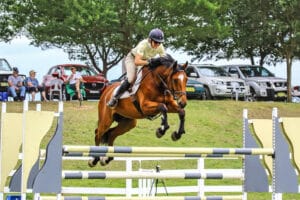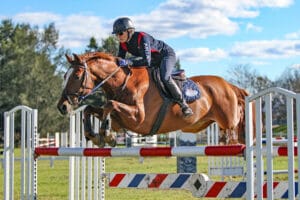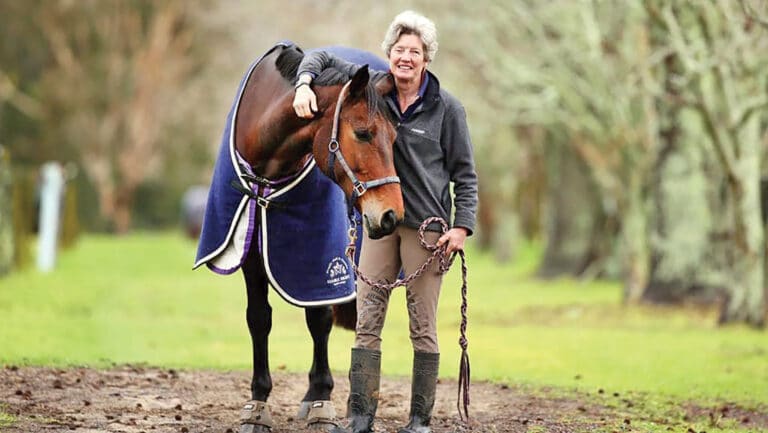The legendary VICKI ROYCROFT has attended six Olympic Games – three as a rider, three as a coach – and knows a thing or two about combinations.
Vicki Roycroft is the only woman to have competed in two equestrian disciplines at the Olympics – eventing once and jumping twice. She’s also competed in three World Championships and four World Cup finals, and to date has won more World Cup Qualifiers than anyone else in Australia. Another arrow in her quiver is her ranking as a qualified Level 3 EA Coach – so, all in all, it’s fair to say she knows a thing or two about negotiating a line of fences! We were lucky enough to glean some brilliant pearls of wisdom from Vicki that you can take away and immediately implement with your own horse.
Keep the horse saying yes
Among the brightly coloured poles and fill, the combination is a course staple. This set of obstacles always elicits much chatter from competitors as they walk the course. How many strides? What line to take? How to ride to it? Well, now’s the time to tame those doubles and triples.

Vivarchi, bred and co-owned by Warwick and Sophie Miller, competing at Sydney Jump Club (Image by Ashleigh Truscott Photography).
Here’s what Vicki has to say: “The thing is, the combination is the easiest place to scare a horse. If you screw up at a single fence, then you just make your one mistake and ok, you’ve knocked a rail down, or made the horse bust its guts a bit. But if you do it at a combination, you screw them up for two or three fences.”
Vicki points out that while your horse can forgive you for making a mistake at a single fence, a combination is a different proposition: “They’re going to say ‘this person doesn’t know what the hell they’re doing’, and they’ll obviously start to doubt you. Then you’ve got problems to repair.”
Getting further into the details, Vicki mentions her musings are not her own original thoughts, but rather what she’s learned along her journey. “I’ve been very blessed to be coached by the best people on the planet: Wayne Roycroft, Bill Roycroft, George Morris, and that’s all the stuff that I follow. George’s philosophy was always ‘over, under or through’. Once a horse starts, I’d rather have a rail from an over-ride than an under-ride, because that way you’re not going to shatter your horse’s confidence. If you under-ride a fence, especially a combination, and they get into a bit of trouble, or even if they don’t get into trouble and manage to struggle their way through it, you’ve scared them. The next time they’re going to think hang on, this is a bit scary, so you’ve got to either ride it a bit harder or go down a level, where you can re-gain their confidence,” she says.

CW Conquest, then owned by Maryam Reda, showing wonderful technique at Sydney Jump Club (Image courtesy Vicki Roycroft).
Summing it up, Vicki lists her key points. “Number one, if in doubt, over-ride it a bit and, number two, if you do encounter problems, step back and go down a level. Don’t try and fix things at the same level the horse was frightened at.” She frames it like this: “The guiding principle is that it only takes five minutes to scare a horse, but then it takes five weeks to do the repair work. You’ve always got to work on the horse’s attitude being ‘what would you like me to do now?’ Not, ‘I really don’t want to do that!’”
Think like a horse
There are exercises a horse and rider can, and should be doing during training to prepare for riding combination fences well. “Straightness is the big deal, and it’s not just straightness approaching the fence, but straightness after a fence – being aware of maintaining a straight line. A stop is the end result of a lot of problems. The horse may have already lost confidence a bit, or you’ve let the horse have a big drift, or get crooked. Riders have got to start thinking like a horse. A show jump fence is about three or four meters wide, the horse’s first logical thought is ‘well, if I deviate my line two metres one way or the other and go round this, then why should I spend the effort to go over it?’”
Vicki highlights a big issue that green riders should be conscious of, something she often sees playing out: “Be aware of what is happening after the fence. You might have a difficult turn to make, or your next fence might be five strides away on a straight line. You’ve got to be straight. You’ve got to be in control for the whole line, not just in front of the fence, but also after it. It’s critical, of course, with a combination that the horse stays straight.”
She says that the better you ride up to and away from single fences, the better you will ride combination fences: “A lot of horses have a drift or are a bit crooked, but you’ve got to try and keep them as straight as you possibly can, so they’re focused on the job of jumping the fence.”

Dynamite Bay (co-owned with Robynne McTaggert of Noblewood Park Holsteiner Stud) showing plenty of scope (Image by OzShotz).
It’s not all about jumps
Whether you’re aiming to clear a double, triple, or just a single fence, if a horse is unbalanced, crooked and unrideable on the flat, it’s not likely to jump well. “Riders need to focus on jumping being ninety per cent flatwork. It’s about getting to the fence, then getting away from the fence and getting to the next fence. It’s not exclusively dressage flatwork, because in a dressage test you’re in a sixty by twenty metre arena and you know exactly where you’re going to do all your movements. In a jumping arena everything happens a lot quicker,” says Vicki. “You go from collected canter to gallop within a few strides and you do a different course every time. So, our flatwork has to involve horses that are a lot more prompt to our aids and stay very balanced all the time. It doesn’t matter if they get a little high in the head at some point, as long as they’re on their hocks and as long as the engine, the hindquarter, is working.”
While you might be able to get by up to a point, you need to be more particular and accurate as you move up through the levels. “Sixty centimetres, ninety centimetres may not be such a big deal, the horse can manage that. But once you start getting a little more ambitious, you’ve got to be a better rider on a better educated horse,” Vicki explains. “That’s why we’ve got to focus so much of our effort into getting a good canter, getting good balance, getting a good take off distance – then you can make it easy for a horse. Unless it’s a double of verticals, you’re going to ride a combination a little more aggressively than you’d ride a normal fence.”
Toolbox favourites
While Vicki doesn’t mind jumping grids, she says that for her they’re not the be all and end all of productive jump schooling: “Grids are quite good in clinics because you can work on a rider’s position and they’re also good to get a horse a bit sharpened up and make them think about their technique more, but grids are just one of the many tools in the box. I prefer related distances, like up to five and six strides so riders can develop their judgement and develop an eye for a distance.”
When it comes to poles, Vicki is a raving fan: “I love poles, I love cavaletti! I do a lot of those, because again, they help train your eye and judgement when riding a line onto a fence and away from a fence.”

Now owned by the Miles family, Vivarchi won the SJC 7 Year Old Championship in 2018 (Image by Jenny Sheppard Photography).
She believes poles are great for taking off the pressure, but still improving your technique over combinations of any variety. “It’s actually harder to canter a pole on the ground than canter a fence, because when you’re cantering a fence, there are two pairs of eyes on the fence, or in my case, one and a half pairs, because I’ve only got one eye,” she chuckles, “but the horse isn’t looking to judge a distance to a pole, so it’s always a little more difficult to ride it. It’s good practise, you’re not going to scare a horse cantering over a pole or cavaletti, and the rider is going to make themselves better at picking a smooth distance.”
For Vicki an overarching key to victory while jumping combinations is confidence. Both the horse and rider have to be confident in one level before they go up to the next. A double or triple has the potential to be the easiest place to frighten the horse, so take the time to improve it by training at home on the flat and over poles, as well as over actual fences. Improved straightness and balance, with a powerful engine underneath you, will help set you on the straight line to combination success.
Feature Image: Congo Z, the last horse Vicki won a World Cup Qualifier with, at home at the Roycroft Stables in Mount White (Image courtesy Vicki Roycroft).



